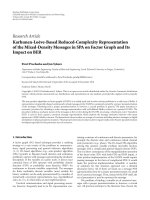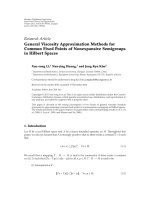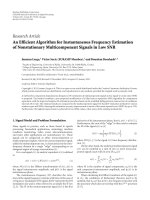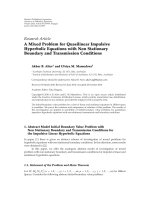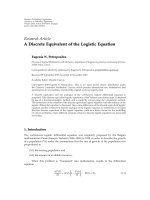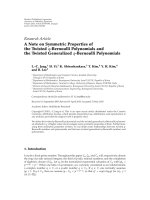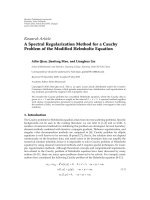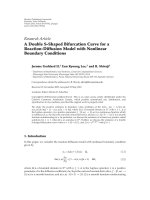Báo cáo sinh học: " Research Article A Spectral Regularization Method for a Cauchy Problem of the Modified Helmholtz Equation" potx
Bạn đang xem bản rút gọn của tài liệu. Xem và tải ngay bản đầy đủ của tài liệu tại đây (604.18 KB, 13 trang )
Hindawi Publishing Corporation
Boundary Value Problems
Volume 2010, Article ID 212056, 13 pages
doi:10.1155/2010/212056
Research Article
A Spectral Regularization Method for a Cauchy
Problem of the Modified Helmholtz Equation
Ailin Qian, Jianfeng Mao, and Lianghua Liu
School of Mathematics and Statistics, Xianning College, Xianning, Hubei 437100, China
Correspondence should be addressed to Ailin Qian,
Received 15 December 2009; Accepted 9 May 2010
Academic Editor: Salim Messaoudi
Copyright q 2010 Ailin Qian et al. This is an open access article distributed under the Creative
Commons Attribution License, which permits unrestricted use, distribution, and reproduction in
any medium, provided the original work is properly cited.
We consider the Cauchy problem for a modified Helmholtz equation, where the Cauchy data is
given at x 1 and the solution is sought in the interval 0 <x<1. A spectral method together
with choice of regularization parameter is presented and error estimate is obtained. Combining
the method of lines, we formulate regularized solutions which are stably convergent to the exact
solutions.
1. Introduction
The Cauchy problem for Helmholtzequation arises from inverse scattering problems. Specific
backgrounds can be seen in the existing literature; we can refer to 1–6 andsoforth.A
number of numerical methods for stabilizing this problem are developed. Several boundary
element methods combined with iterative, conjugate gradient, Tikhonov regularization, and
singular value decomposition methods are compared in 6. Cauchy problem for elliptic
equations is well known to be severely ill-posed 7; that is, the solution does not depend
continuously on the boundary data, and small errors in the boundary data can amplify the
numerical solution infinitely; hence it is impossible to solve Cauchy problem of Helmholtz
equation by using classical numerical methods and it requires special techniques, for exam-
ple, regularization methods. Although theoretical concepts and computational implementa-
tion related to the Cauchy problem of Helmholtz equation have been discussed by many
authors 8–11, there are many open problems deserved to be solved. For example, many
authors have considered the following Cauchy problem of the Helmholtz equation 8–11:
u
xx
u
yy
− k
2
u
x, y
0, 0 <x<1, −∞ <y<∞,
u
1,y
g
y
, −∞ <y<∞,
u
x
1,y
0, −∞ <y<∞.
1.1
2 Boundary Value Problems
However, the boundary condition u
x
1,y0 is very strict. If the boundary condition
is replaced by u
x
1,yhy, where hy is a function of y, then their methods cannot be
applied easily. Therefore, in this paper, we consider the following Cauchy problem for the
Helmholtz equation:
u
xx
u
yy
− k
2
u
x, y
0, 0 <x<1, −∞ <y<∞,
u
1,y
g
y
, −∞ <y<∞,
u
x
1,y
h
y
, −∞ <y<∞.
1.2
We want to seek the solution in the interval 0, 1 from the Cauchy data pairs g,h
located at x 1. Of course, since g and h are assumed to be measured, there must be
measurement errors, and we would actually have noisy data function g
δ
,h
δ
∈ L
2
R,for
which the measurement errors h − h
δ
and g − g
δ
are small. Here and in the following
sections, ·denotes the L
2
R norm. Thus 1.2 is a noncharacteristic Cauchy problem with
appropriate Cauchy data u, u
x
given on the line x 1.
However, the ill-posedness is caused by high frequency. By introducing a “cutoff”
frequency we can obtain a well-posed problem. This method has been used for solving
inverse heat conduction problem 12, and sideways heat equation 13, sideways parabolic
equation 14. An error estimate for the proposed method can be found in Section 2.The
implementation of the numerical method is explained.
2. Regularization and Error Estimate
First, let u be the Fourier transform of u:
u
x, ξ
1
√
2π
∞
−∞
u
x, y
e
−iξy
dy, ξ ∈ R.
2.1
Taking Fourier transformation for 1.2, we have a family of problems parameterized
by ξ:
u
xx
x, ξ
− ξ
2
u
x, ξ
− k
2
u
x, ξ
0, 0 <x<1,ξ∈ R,
u
1,ξ
g
ξ
,ξ∈ R,
u
x
1,ξ
h
ξ
,ξ∈ R.
2.2
The solution can easily be verified to be
u
x, ξ
−
h
ξ
ξ
2
k
2
sinh
1 − x
ξ
2
k
2
g
ξ
cosh
1 − x
ξ
2
k
2
.
2.3
Boundary Value Problems 3
Following the idea of Fourier method, we consider 2.2 only for |ξ| <ξ
c
by cutting off
high frequency and define a regularized solution:
u
c
x, ξ
χ
c
ξ
u
x, ξ
, 2.4
where χ
c
is the characteristic function of the interval −ξ
c
,ξ
c
.Thesolutionu
c
x, y can be
found by using the inverse Fourier transform. Define the regularized solution with measured
data g
δ
,h
δ
by u
δ
c
.Thedifference between the exact solution ux, y and the regularized
solution u
δ
c
x, y can be divided into two parts:
u
x, ·
− u
δ
c
x, ·
≤u − u
c
u
c
− u
δ
c
R
a
R
b
,
2.5
where
R
2
a
|ξ|>ξ
c
|ux, ξ|
2
dξ, R
2
b
ξ
c
−ξ
c
|u
c
− u
δ
c
|
2
dξ.
2.6
We rewrite 2.2 as a system of ordinary differential equations:
ξ
2
k
2
u
u
x
x
0
ξ
2
k
2
ξ
2
k
2
0
ξ
2
k
2
u
u
x
, 0 ≤ x ≤ 1.
2.7
Letting Ux
ξ
2
k
2
u u
x
T
, we can rewrite 2.7 as
U
x
x
AU
x
, 0 ≤ x ≤ 1,U
1
ξ
2
k
2
g
h
, 2.8
where the matrix A is the one in 2.7. The reason for using
ξ
2
k
2
u instead of u in the
definition of Ux is that with this choice, the matrix A is normal and hence diagonalized by
a unitary matrix. The eigenvalues of A are λ
1,2
±
ξ
2
k
2
. Thus we can factorize A as
A XΛX
H
, Λ
ξ
2
k
2
0
0 −
ξ
2
k
2
, 2.9
where X is a unitary matrix, X
H
X I; it follows that the solution of the system 2.8 can be
written as
U
x
Xe
Λx−1
X
H
U
1
.
2.10
Since X is unitary, X 1 and therefore
Ux
2
2
≤e
Λx−1
2
2
·U1
2
2
,
2.11
4 Boundary Value Problems
where ·
2
denotes both the Euclidean norm in the complex vector space C
2
and the
subordinate matrix norm, remembering U
ξ
2
k
2
u u
x
T
in 2.11,weobtain
ξ
2
k
2
u
2
|u
x
|
2
≤ e
2
√
ξ
2
k
2
1−x
ξ
2
k
2
u
1,ξ
2
|u
x
1,ξ|
2
. 2.12
This inequality is valid for all ξ ∈ R and we can integrate over ξ and use the Parseval theorem
to obtain estimates for u and u
x
in the L
2
R-norm. First we will prove a bound on the
difference between any two regularized solutions 2.4. We have errors in the measured gy
and hy. These two cases are treated separately.
Lemma 2.1. Assume that one has two regularized solutions u
1
and u
2
defined by 2.4,withthe
Cauchy data g,h
1
and g,h
2
.Then
u
1
x, ·
− u
2
x, ·
≤
e
√
ξ
2
c
k
2
1−x
− 1
ξ
2
c
k
2
h
1
− h
2
.
2.13
Proof. The function w u
1
− u
2
satisfies the differential equation; thus w solves 2.2,with
initial data given by
w
1, ·
0,w
x
1, ·
h
1
−
h
2
χ
c
, 2.14
and thus w satisfies inequality2.12 . We have
w
x
x, ξ
2
≤ e
2
√
ξ
2
k
2
1−x
|w
x
1,ξ|
2
≤ e
2
√
ξ
2
c
k
2
1−x
|
h
1
−
h
2
|
2
.
2.15
If 0 ≤ z ≤ 1, then
w
z, ξ
−
1
z
w
x
x, ξ
dx w
1,ξ
−
1
z
w
x
x, ξ
dx
2.16
holds. By inserting 2.15 into 2.16 we get
|
w
z, ξ
|
1
z
w
x
x, ξ
dx
≤
1
z
|
w
x
|
dx ≤
1
z
e
√
ξ
2
c
k
2
1−x
|
w
x
1,ξ
|
dx
e
√
ξ
2
c
k
2
1−z
− 1
ξ
2
c
k
2
·
|
w
x
1,ξ
|
.
2.17
Boundary Value Problems 5
If we insert w u
1
− u
2
and integrate over ξ, then we obtain
∞
−∞
u
1
− u
2
2
dξ ≤
⎛
⎜
⎝
e
√
ξ
2
c
k
2
1−x
− 1
ξ
2
c
k
2
⎞
⎟
⎠
2
·
∞
−∞
h
1
ξ
−
h
2
ξ
2
dξ.
2.18
Thus 2.13 holds.
Lemma 2.2. Assume that one has two regularized solutions u
1
and u
2
defined by 2.4,withthe
Cauchy data g
1
,h and g
2
,h.Then
u
1
x, ·
− u
2
x, ·
≤e
√
ξ
2
c
k
2
1−x
g
1
− g
2
.
2.19
Proof. The function w u
1
− u
2
satisfies the differential equation, with initial data given by
w
1,ξ
g
1
− g
2
χ
c
,w
x
1,ξ
0, 2.20
and thus inequality 2.12 holds. It follows that
ξ
2
k
2
w
x, ξ
2
≤ e
2
√
ξ
2
k
2
1−x
|
ξw
1,ξ
|
2
,
2.21
and thus, for ξ
2
k
2
/
0,
wx, ξ
2
≤ e
2
√
ξ
2
k
2
1−x
|w1,ξ|
2
.
2.22
By integrating over the interval −ξ
c
,ξ
c
,weget
ξ
c
−ξ
c
|wx, ξ|
2
dξ ≤
ξ
c
−ξ
c
e
2
√
ξ
2
k
2
1−x
|w1,ξ|
2
dξ ≤ e
2
√
ξ
2
c
k
2
1−x
ξ
c
−ξ
c
|w1,ξ|
2
dξ.
2.23
Since w u
1
− u
2
is equal to zero outside the interval −ξ
c
,ξ
c
, we can extend the integrals.
Inserting w u
1
− u
2
, we get
∞
−∞
u
1
− u
2
2
dξ ≤ e
2
√
ξ
2
c
k
2
1−x
·
∞
−∞
|g
1
− g
2
|
2
dξ.
2.24
This is precisely 2.19.
Next we prove that, for the regularized problem, we have stable dependence of the
data. By using the two previous lemmas, we get the following.
6 Boundary Value Problems
Lemma 2.3 stability. Assume that u
c
is the regularized solution 2.4, with exact data g,h, and
u
δ
c
is the regularized solution with noisy data g
δ
,h
δ
;then
u
c
− u
δ
c
≤e
√
ξ
2
c
k
2
1−x
⎛
⎜
⎝
g −g
δ
h − h
δ
ξ
2
c
k
2
⎞
⎟
⎠
. 2.25
Proof. Let u
1
be a regularized solution defined by 2.4,withdatag,h
δ
. Then by Lemma 2.1,
u
c
− u
1
≤
e
√
ξ
2
c
k
2
1−x
− 1
ξ
2
c
k
2
h − h
δ
≤
e
√
ξ
2
c
k
2
1−x
ξ
2
c
k
2
h − h
δ
.
2.26
Using Lemma 2.2, we have
u
1
− u
δ
c
≤e
√
ξ
2
c
k
2
1−x
g −g
δ
.
2.27
By the triangle inequality,
u
c
− u
δ
c
≤u
c
− u
1
u
1
− u
δ
c
≤e
√
ξ
2
c
k
2
1−x
⎛
⎜
⎝
g −g
δ
h − h
δ
ξ
2
c
k
2
⎞
⎟
⎠
. 2.28
This completes the proof.
By Lemma 2.3 the regularized solution depends continuously on the data. Next we
derive a bound on the truncation error when we neglect frequencies |ξ|≥ξ
c
in 2.3.Sofar
we have not used any information about u for x>1; we, assume that the Helmholtz equation
u
xx
u
yy
−k
2
u 0 is valid in a large interval 0 <x<L,L>1. By imposing a priori bounds on
the solution at x 0andatx>1, we obtain an estimate of the difference between the exact
solution u and a regularized solution u
c
with “cutoff” level ξ
c
. This is a convergence result
in the sense that u
c
→ u as ξ
c
→∞for the case of exact data g, h. The following estimate
holds.
Lemma 2.4 convergence. Suppose that u is the solution of the problem 2.2, and that the
Helmholtz equation is valid for 0 <x<L. Then the difference between u and a regularized solution
u
c
can be estimated:
u
x, ·
− u
c
x, ·
≤C
e
−x
√
ξ
2
c
k
2
u
0, ·
e
x−L
√
ξ
2
c
k
2
u
L, ·
,
2.29
where the constant C is defined by
C sup
0≤x≤L,
ξ
/
0
1 − e
−2x
√
ξ
2
k
2
1 − e
−2L
√
ξ
2
k
2
< 2.
2.30
Boundary Value Problems 7
Proof. The solution of 2.2 can be written in the floowing form:
u Ae
x
√
ξ
2
k
2
Be
−x
√
ξ
2
k
2
,
2.31
where A and B can be determined from the boundary conditions:
11
e
L
√
ξ
2
k
2
e
−L
√
ξ
2
k
2
A
B
u
0,ξ
u
L, ξ
. 2.32
Solving for A and B we find that the solution can be written:
u
x, ξ
ϕ
L − x, ξ
u
0,ξ
ϕ
x, ξ
u
L, ξ
, 2.33
where
ϕ
x, ξ
e
x
√
ξ
2
k
2
− e
−x
√
ξ
2
k
2
e
L
√
ξ
2
k
2
− e
−L
√
ξ
2
k
2
e
x−L
√
ξ
2
k
2
1 − e
−2x
√
ξ
2
k
2
1 − e
−2L
√
ξ
2
k
2
.
2.34
We make the observation that
ϕ
x, ξ
≤ Ce
x−L
√
ξ
2
k
2
2.35
and that
ϕ
L − x, ξ
≤ Ce
−x
√
ξ
2
k
2
.
2.36
Using the expression 2.33 and the triangle inequality, we get
u − u
c
≤ϕ
L − x, ·
u
0, ·
− u
c
0, ·
ϕ
x, ·
u
L, ·
− u
c
L, ·
. 2.37
The first term on the right-hand side satisfies
ϕL − x, ·u0, · − u
c
0, ·
2
≤
|ξ|>ξ
c
C
2
e
−2x
√
ξ
2
k
2
|u0,ξ|
2
dξ
≤ C
2
e
−2x
√
ξ
2
c
k
2
|ξ|>ξ
c
|u0,ξ|
2
dξ
≤ C
2
e
−2x
√
ξ
2
c
k
2
u0,ξ
2
.
2.38
8 Boundary Value Problems
Similarly, the second term can be estimated:
ϕx, ·uL, · − u
c
L, ·
2
≤ C
2
e
−2L−x
√
ξ
2
c
k
2
·uL, ξ
2
.
2.39
By combining these two expressions, we have
u
x, ·
− u
c
x, ·
≤C
e
−x
√
ξ
2
c
k
2
u
0, ·
e
−L−x
√
ξ
2
c
k
2
u
L, ·
.
2.40
Thus the proof is complete.
Remark 2.5. The constant C is well defined, but its value has to be estimated. From a numerical
computation we conclude that C<2.
Remark 2.6. When solving 2.2 numerically we need Cauchy data u, u
x
g
δ
,h
δ
,along
the line x 1. The most natural way to obtain this is to use two thermocouples, located
at x 1, and x L, and compute h
δ
by solving a well-posed problem for the Helmholtz
equation in the interval 1,L. Hence it is natural to assume knowledge about u at a second
point.
Let us summarize what we have so far. The constant C in Lemma 2.4 is unchanged.
The propagated data error is estimated using Lemma 2.3:
R
b
u
c
− u
δ
c
≤e
√
ξ
2
c
k
2
1−x
⎛
⎜
⎝
g −g
δ
h − h
δ
ξ
2
c
k
2
⎞
⎟
⎠
, 2.41
and the truncation error is estimated using Lemma 2.4:
R
a
u − u
c
≤C
e
−x
√
ξ
2
c
k
2
u
0, ·
e
x−L
√
ξ
2
c
k
2
u
L, ·
. 2.42
These two results can be combined into an error estimate for the spectral method. This is
demonstrated in two examples.
Example 2.7. Suppose that ux, ·≤E, and that we have an estimate of the noise level,
g − g
δ
h − h
δ
≤δ.IfL ≥ 3 and if we choose ξ
c
logE/δ
2
− k
2
, with this choice,
then by expression 2.42,
R
a
≤ Ee
−x
√
ξ
2
c
k
2
C
1 e
2x−L
√
ξ
2
c
k
2
≤ CE
1−x
δ
x
1 e
−1
≤ 2E
1−x
δ
x
,
2.43
Boundary Value Problems 9
where we have assume that 0 <x<1 and used the bound C<2. By expression 2.41,
R
b
≤ e
√
ξ
2
c
k
2
1−x
δ ≤ E
1−x
δ
x
.
2.44
Thus we obtain an error estimate:
u
x, ·
− u
δ
c
x, ·
≤R
a
R
b
≤ 3E
1−x
δ
x
.
2.45
Note that, under these assumptions, ξ
c
logE/δ
2
− k
2
can be used as a rule for selecting
the regularization parameter.
Example 2.8. Suppose that the Helmholtz equation is valid in the interval 0 ≤ x ≤ 5and
that we have a priori bounds u0, ·≤1andu5, ·≤0.5. Furthermore, we assume that
the measured data satisfies g − g
δ
≤10
−3
and h − h
δ
≤0.5 · 10
−2
. Then we have the
estimates:
R
b
u
c
− u
δ
c
≤e
1−x
√
ξ
2
c
k
2
⎛
⎜
⎝
10
−3
0.5 ·
10
−2
ξ
2
c
k
2
⎞
⎟
⎠
,
R
a
u − u
c
≤2
e
−x
√
ξ
2
c
k
2
· 1 e
x−5
√
ξ
2
c
k
2
· 0.5
.
2.46
By balancing these two components R
a
and R
b
, we can find a suitable value for the
regularization parameter.
3. Numerical Implementation
In this section, we use the method of Lines. Let
U U
x
⎛
⎜
⎜
⎜
⎜
⎜
⎜
⎜
⎜
⎜
⎜
⎝
U
0
x
U
1
x
U
2
x
.
.
.
U
n
x
⎞
⎟
⎟
⎟
⎟
⎟
⎟
⎟
⎟
⎟
⎟
⎠
≈
⎛
⎜
⎜
⎜
⎜
⎜
⎜
⎜
⎜
⎜
⎜
⎝
U
x, y
0
U
x, y
1
U
x, y
2
.
.
.
U
x, y
n
⎞
⎟
⎟
⎟
⎟
⎟
⎟
⎟
⎟
⎟
⎟
⎠
,
y
i
i
n
,i 0, 1, 2, ,n,
3.1
10 Boundary Value Problems
−4 −3 −2 −10 12 3 4
−0.2
0
0.2
0.4
0.6
0.8
1
1.2
1.4
y
Approximation
Exact solution
u0.4,y and its approximation
Figure 1: x 0.4,δ 1 ∗10
−5
,ξ
c
11.35.
and then we can obtain
U
x
U
x
0D
I0
U
x
U
,
U
x
1
U
1
H
G
,
3.2
where
H
⎛
⎜
⎜
⎜
⎜
⎜
⎜
⎜
⎜
⎜
⎜
⎜
⎝
U
x
1,y
0
U
x
1,y
1
U
x
1,y
2
.
.
.
U
x
1,y
n
⎞
⎟
⎟
⎟
⎟
⎟
⎟
⎟
⎟
⎟
⎟
⎟
⎠
,
G
⎛
⎜
⎜
⎜
⎜
⎜
⎜
⎜
⎜
⎜
⎜
⎜
⎝
U
1,y
0
U
1,y
1
U
1,y
2
.
.
.
U
1,y
n
⎞
⎟
⎟
⎟
⎟
⎟
⎟
⎟
⎟
⎟
⎟
⎟
⎠
.
3.3
Boundary Value Problems 11
−4 −3 −2 −10 12 3 4
−0.2
0
0.2
0.4
0.6
0.8
1
1.2
1.4
y
Approximation
Exact solution
u0,y and its approximation
Figure 2: x 0,δ 1 ∗10
−5
,ξ
c
11.35.
−4 −3 −2 −10 12 3 4
−0.2
0
0.2
0.4
0.6
0.8
1
1.2
1.4
y
Approximation
Exact solution
u0.4,y and its approximation
Figure 3: x 0.4,δ 1 ∗ 10
−2
,ξ
c
4.45.
The matrix D approximates the second-order derivative u
yy
by spectral cutoff method see
2.Thisordinarydifferential equation system can easily be solved by various numerical
methods.
Example 3.1. It is easy to verify that the function ux, ysin x cosh
√
1 k
2
y/5 k
2
is the
exact solution of 1.2. Now we need to seek the solution ux, ysin x cosh
√
1 k
2
y/5
k
2
, where 0 ≤ x<1 from the Cauchy data pairs u1,ysin 1cosh
√
1 k
2
y/5 k
2
and
u
x
1,ycos 1 cosh
√
1 k
2
y/5 k
2
.
12 Boundary Value Problems
−4 −3 −2 −10 12 3 4
−0.2
0
0.2
0.4
0.6
0.8
1
1.2
y
Approximation
Exact solution
u0,y and its approximation
Figure 4: x 0,δ 1 ∗10
−2
,ξ
c
4.45.
In our numerical experiment, we give the comparison between the exact solution of
problem 2.2 and its approximation by spectral cutoff method for different noise levels δ and
different locations x. Please see Figures 1, 2, 3,and4. In the experiment, the regularization
parameter is chosen according to the Remark of Remark 2.5, where we take E 1. From the
above results, it is easy to see that the numerical effect of the spectral method works well.
Moreover, we can also see that the lower the noise level δ is, the better the approximate effect
is; the closer to the boundary x 1 the location is, the better the approximate effect is. These
accord with the theory in Section 2.
Acknowledgments
The author wants to express his thanks to the referee for many valuable comments. This
work is supported by the Educational Commission of Hubei Province of China Q20102804,
T201009.
References
1 A. Kirsch, An Introduction to the Mathematical Theory of Inverse Problems, vol. 120 of Applied Mathematical
Sciences, Springer, New York, NY, USA, 1996.
2 I. Harari, P. E. Barbone, M. Slavutin, and R. Shalom, “Boundary infinite elements for the Helmholtz
equation in exterior domains,” International Journal for Numerical Methods in Engineering, vol. 41, pp.
1105–1131, 1998.
3 L. Marin, L. Elliott, P. J. Heggs, D. B. Ingham, D. Lesnic, and X. Wen, “An alternating iterative
algorithm for the Cauchy problem associated to the Helmholtz equation,” Computer Methods in Applied
Mechanics and Engineering, vol. 192, no. 5-6, pp. 709–722, 2003.
4 L. Marin, L. Elliott, P. J. Heggs, D. B. Ingham, D. Lesnic, and X. Wen, “Conjugate gradient-boundary
element solution to the Cauchy problem for Helmholtz-type equations,” Computational Mechanics, vol.
31, no. 3-4, pp. 367–377, 2003.
Boundary Value Problems 13
5 T. Regi
´
nska and K. Regi
´
nski, “Approximate solution of a Cauchy problem for the Helmholtz
equation,” Inverse Problems, vol. 22, no. 3, pp. 975–989, 2006.
6 L. Marin, L. Elliott, P. J. Heggs, D. B. Ingham, D. Lesnic, and X. Wen, “Comparison of regularization
methods for solving the Cauchy problem associated with the Helmholtz equation,” International
Journal for Numerical Methods in Engineering, vol. 60, no. 11, pp. 1933–1947, 2004.
7 J. Hadamard, Lectures on the Cauchy Problem in Linear Partial Differential Equations, Yale University
Press, New Haven, Conn, USA, 1923.
8 X. T. Xiong and C. L. Fu, “Two approximate methods of a Cauchy problem for the Helmholtz
equation,” Computational & Applied Mathematics, vol. 26, no. 2, pp. 285–307, 2007.
9 C. L. Fu, X. L. Feng, and Z. Qian, “The Fourier regularization for solving the Cauchy problem for the
Helmholtz equation,” Applied Numerical Mathematics, vol. 59, no. 10, pp. 2625–2640, 2009.
10 H. H. Qin and T. Wei, “Modified regularization method for the Cauchy problem of the Helmholtz
equation,” Applied Mathematical Modelling, vol. 33, no. 5, pp. 2334–2348, 2009.
11 A. L. Qian, X. T. Xiong, and Y. J. Wu, “On a quasi-reversibility regularization method for a Cauchy
problem of the Helmholtz equation,” Journal of Computational and Applied Mathematics, vol. 233, no. 8,
pp. 1969–1979, 2010.
12 L. Eld
´
en and F. Berntsson, “Spectral and wavelet methods for solving an inverse heat conduction
problem,” in Inverse Problems in Engineering Mechanics, pp. 3–10, Elsevier, Oxford, UK, 1998.
13 F. Berntsson, “A spectral method for solving the sideways heat equation,” Inverse Problems, vol. 15,
no. 4, pp. 891–906, 1999.
14 X. T. Xiong, C. L. Fu, and J. Cheng, “Spectral regularization methods for solving a sideways parabolic
equation within the framework of regularization theory,” Mathematics and Computers in Simulation,
vol. 79, no. 5, pp. 1668–1678, 2009.


